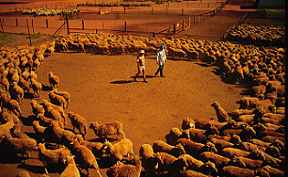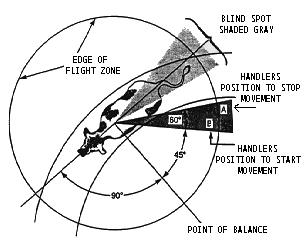

Animals (or herding animals, at the very least) can be thought of as having a flight zone which encircles their bodies. This flight zone is, in effect, the animal's personal space, intrusion into which is not acceptable to or comfortable for the animal. The size of this flight zone is determined by a number of factors: tamer and calmer animals have smaller ones, whereas animals approached from directly in front have larger ones. When an animal's flight zone is violated, it will usually turn away and attempt to maintain its personal space. If the violation occurs behind the animal's point of balance, then the animal will tend to move forward, and if the violation occurs in front of the point of balance, then the animal will tend to move backward.
For instance, the sheep in the photograph below are keeping their distance from their handlers (maintaining their flight zones) and are moving in the opposite direction from that in which their handlers are moving (as influenced by the relation between the handlers' positions and the animals' points of balance).

home
boid rules
boid models
applications
bibliography
last updated: May 5, 2000 (chris boone,
sam hillier)